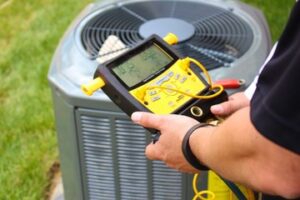AIR CONDITIONING REPAIR LOVELAND OH is essential for maintaining indoor comfort and improving energy efficiency. Over time, even the most reliable systems can experience wear and tear, leading to issues that require immediate attention. Understanding the complexities of air conditioning repair allows homeowners and technicians to address problems efficiently, minimize downtime, and extend the lifespan of the system.

Modern air conditioning units have become more sophisticated, incorporating advanced technology and smart controls, which require specialized knowledge and tools for proper diagnosis and repair. The growing focus on energy efficiency and environmental impact has also introduced new challenges and opportunities in the repair and maintenance of air conditioning systems.
One of the most common issues with air conditioning systems is poor airflow, which can result from clogged filters, damaged ductwork, or blocked vents. When airflow is restricted, the system has to work harder to maintain the desired temperature, leading to increased energy consumption and higher utility bills. Cleaning or replacing air filters regularly is a simple yet effective way to improve airflow and prevent strain on the system. In some cases, duct inspection may be necessary to identify leaks or obstructions that disrupt the even distribution of cool air. Advanced diagnostic tools, such as thermal imaging cameras, allow technicians to detect hidden issues within ductwork and recommend targeted solutions without invasive procedures.
Refrigerant leaks are another common problem that can compromise the performance of an air conditioning unit. Low refrigerant levels reduce the system’s ability to cool the air, resulting in uneven temperatures and increased humidity levels. Detecting and repairing leaks require specialized equipment and knowledge of refrigerant handling regulations. Modern leak detection methods use electronic sniffers, UV dyes, and ultrasonic sensors to identify even the smallest leaks with precision. Once a leak is identified, repairing it involves sealing the damaged area and recharging the system with the correct type and amount of refrigerant. Ensuring that the refrigerant charge is balanced is critical for maintaining energy efficiency and preventing further issues.
Compressor failure is one of the most serious air conditioning issues, often resulting from electrical problems, overheating, or poor maintenance. The compressor is responsible for circulating refrigerant through the system and maintaining pressure levels. When it fails, the entire cooling process is disrupted. Diagnosing compressor issues involves testing electrical connections, checking refrigerant levels, and inspecting the motor for signs of wear or damage. In some cases, replacing the compressor may be necessary, but early intervention and proper maintenance can often prevent total failure. Modern systems are equipped with smart sensors that monitor compressor performance and provide alerts when issues are detected, allowing for timely repairs and avoiding costly breakdowns.
Thermostat malfunctions can also cause inconsistent cooling and inefficient operation. If the thermostat is not calibrated correctly or is located in an area with direct sunlight or drafts, it may send inaccurate signals to the system. Smart thermostats, which have become increasingly popular, offer remote monitoring and control through mobile apps, allowing users to adjust settings and troubleshoot issues from anywhere. Replacing an outdated or malfunctioning thermostat with a smart model can improve overall system performance and provide more accurate temperature control. Programming temperature schedules and using geofencing technology can further enhance efficiency by adjusting settings based on occupancy patterns.
Frozen evaporator coils are a sign of restricted airflow or low refrigerant levels. When the coils freeze, the system struggles to absorb heat from the air, resulting in poor cooling performance and increased energy consumption. Thawing the coils and identifying the underlying cause of the freeze are essential steps in resolving the issue. Cleaning dirty coils, replacing clogged filters, and checking refrigerant levels can prevent future freezing. Modern air conditioning systems are designed with advanced defrost cycles that automatically detect and resolve coil freezing issues, improving reliability and reducing the need for manual intervention.
Electrical issues, such as faulty wiring, blown fuses, and tripped circuit breakers, can prevent an air conditioning system from functioning properly. Diagnosing electrical problems requires a thorough inspection of the control board, capacitors, and contactors. Testing voltage levels and continuity using a multimeter helps identify damaged components and faulty connections. Replacing worn-out parts and securing loose wires can restore proper electrical flow and prevent further damage to the system. Advanced air conditioning systems often feature surge protection and circuit monitoring to prevent electrical failures and enhance system longevity.
Drainage problems can lead to water damage and mold growth if not addressed promptly. When the condensate drain line becomes clogged with debris, algae, or mineral buildup, water can back up into the system and cause leaks or overflow. Flushing the drain line with a cleaning solution or using a wet vacuum to remove blockages can restore proper drainage. Installing a float switch that shuts off the system when the drain pan overflows can prevent water damage and signal the need for maintenance. Regular inspection and cleaning of the drain line can prevent recurring issues and improve overall system performance.
Fan motor failure is another issue that can compromise the efficiency and performance of an air conditioning system. The fan motor is responsible for circulating air over the evaporator coils and expelling heat from the condenser unit. If the motor fails, the system may overheat or struggle to maintain the desired temperature. Diagnosing motor issues involves testing the capacitor, inspecting the fan blades for damage, and checking for signs of overheating. Replacing worn-out bearings, lubricating moving parts, and securing loose components can restore proper fan operation and prevent future failures. Some modern systems feature variable-speed fan motors that adjust airflow based on real-time cooling demands, improving efficiency and reducing wear.
Noise and vibration issues can indicate underlying mechanical problems or loose components. Rattling, buzzing, or grinding noises may result from loose screws, misaligned fan blades, or worn-out bearings. Identifying the source of the noise and tightening or replacing damaged parts can resolve the issue. Anti-vibration mounts and noise-dampening insulation can further reduce operational noise and improve user comfort. Modern air conditioning systems are designed with noise-reduction technology, including quieter compressors and insulated cabinets, to minimize disruption during operation.
Preventive maintenance is essential for extending the lifespan of an air conditioning system and reducing the need for repairs. Regular inspection, cleaning, and tuning of components ensure that the system operates at peak efficiency and prevents minor issues from developing into major problems. Scheduling professional maintenance at least once a year allows technicians to identify potential issues, optimize system performance, and recommend upgrades or repairs as needed. Maintaining proper airflow, refrigerant levels, and electrical connections ensures consistent cooling and energy efficiency throughout the year.
The rise of smart diagnostic tools and remote monitoring has transformed the way air conditioning repairs are conducted. Technicians can now use mobile apps and cloud-based platforms to access real-time data on system performance, identify issues remotely, and recommend solutions before on-site visits. This reduces repair time and costs while improving customer satisfaction. Predictive maintenance algorithms, which analyze historical data and usage patterns, enable technicians to anticipate failures and schedule repairs proactively. The integration of artificial intelligence and machine learning into air conditioning systems has further enhanced predictive maintenance capabilities, allowing for automated adjustments and performance optimization.
Environmental considerations have also influenced modern air conditioning repair practices. The shift toward environmentally friendly refrigerants and energy-efficient components has created new challenges and opportunities for technicians. Proper handling and disposal of refrigerants are regulated to prevent environmental harm and ensure compliance with industry standards. The development of heat pump technology, which provides both heating and cooling capabilities, has introduced new repair and maintenance requirements. Understanding the unique characteristics of heat pump systems and their compatibility with existing infrastructure is essential for effective repair and optimization.
As air conditioning technology continues to evolve, the demand for skilled repair technicians and specialized knowledge will increase. Training programs and certification requirements ensure that technicians are equipped to handle modern systems and emerging technologies. The growing emphasis on energy efficiency, environmental sustainability, and smart home integration will shape the future of air conditioning repair. Advances in materials, diagnostics, and system design will further enhance performance and reliability, reducing the need for frequent repairs and improving overall user satisfaction. The ability to adapt to these changes and embrace new solutions will define the next generation of air conditioning repair and maintenance.
